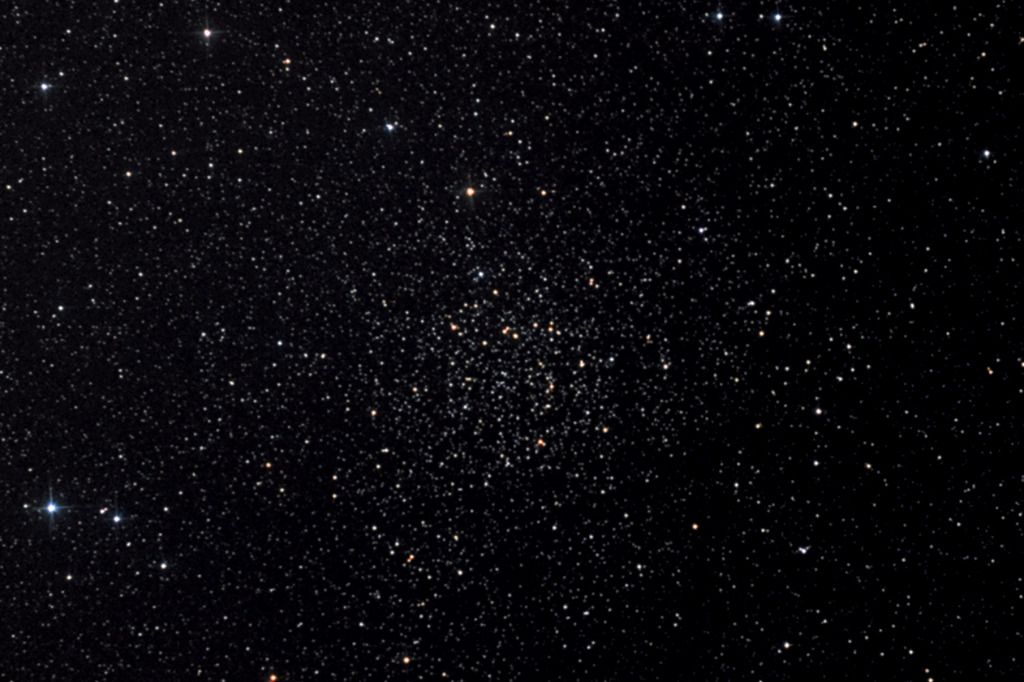NGC 7789, Open Cluster In Cassiopeia
December 11, 2012 at 9:28 am
(This post was last modified: December 11, 2012 at 10:23 am by Tiberius.)
NGC 7789 is an open cluster[1] in Cassiopeia that was discovered by Caroline Herschel in 1783. Her brother William Herschel included it in his catalog as H VI.30. This cluster is also known as "The White Rose" Cluster or "Caroline's Rose" Cluster because when seen visually, the loops of stars and dark lanes look like the swirling pattern of rose petals as seen from above.
NGC 7789 is about 7,600 ly from our solar system.
This image was taken on 08/15/2012 at the LAS James Baker Observatory, in Curby, Indiana
Messier 45, in Taurus
This was typically a very tough egg to crack. I had unknowingly bumped the white balance button on my camera right before I took the frames for this image, with the result that my color data was unrecoverable. The color in this image was generated by creating synthetic color channels. It isn't pefect, but it is close. Still, this is the best image of this cluster I've managed to date.
One of the most interesting things about this cluster is that it is far older than the dust around it would suggest. For a long time, astronomers thought that the cluster was formed within the dust cloud in which it is embedded. That is, until someone far smarter than I am decided to measure the speed and direction of movement of these stars. They discovered that the cluster is moving as one at the same velocity and from the same direction, both of which are different from the velocity and direction the dust is moving. Yep, that means that the cluster just happened on the dust cloud, which apparently was just in its way. The Pleiades are 100 million years old, and are only about 400 light years from us, making them the closest, and largest star cluster near our solar system.
Image:
8x5 min: 40 min total at ISO 800
11 darks, 42 flats, 32 bias frames
Processed with deepSky Stacker and Adobe Photoshop CS3 using the methods of Scott Rosen
Equipment:
Camera: Hutech Modified Canon T1i
Scope: Modified 200m f5 Konus Newtonian with Baader MPCC coma corrector and Baader UV/IR cut filter
Mount: Losmandy G-11 Gemini V.1.04
Tripod: Losmandy Heavy Duty
Autoguide Scope: 80mm f5 Orion Shorty
Autoguide Camera: Orion Starshooter using PhD Guiding
Image acquired on 10/10/2012 at the LAS James Baker Observatory, Curby, Indiana.
'The difference between a Miracle and a Fact is exactly the difference between a mermaid and seal. It could not be expressed better.'
-- Samuel "Mark Twain" Clemens
"I think that in the discussion of natural problems we ought to begin not with the scriptures, but with experiments, demonstrations, and observations".
- Galileo Galilei (1564-1642)
"In short, Meyer has shown that his first disastrous book was not a fluke: he is capable of going into any field in which he has no training or research experience and botching it just as badly as he did molecular biology. As I've written before, if you are a complete amateur and don't understand a subject, don't demonstrate the Dunning-Kruger effect by writing a book about it and proving your ignorance to everyone else! "
- Dr. Donald Prothero
-- Samuel "Mark Twain" Clemens
"I think that in the discussion of natural problems we ought to begin not with the scriptures, but with experiments, demonstrations, and observations".
- Galileo Galilei (1564-1642)
"In short, Meyer has shown that his first disastrous book was not a fluke: he is capable of going into any field in which he has no training or research experience and botching it just as badly as he did molecular biology. As I've written before, if you are a complete amateur and don't understand a subject, don't demonstrate the Dunning-Kruger effect by writing a book about it and proving your ignorance to everyone else! "
- Dr. Donald Prothero









